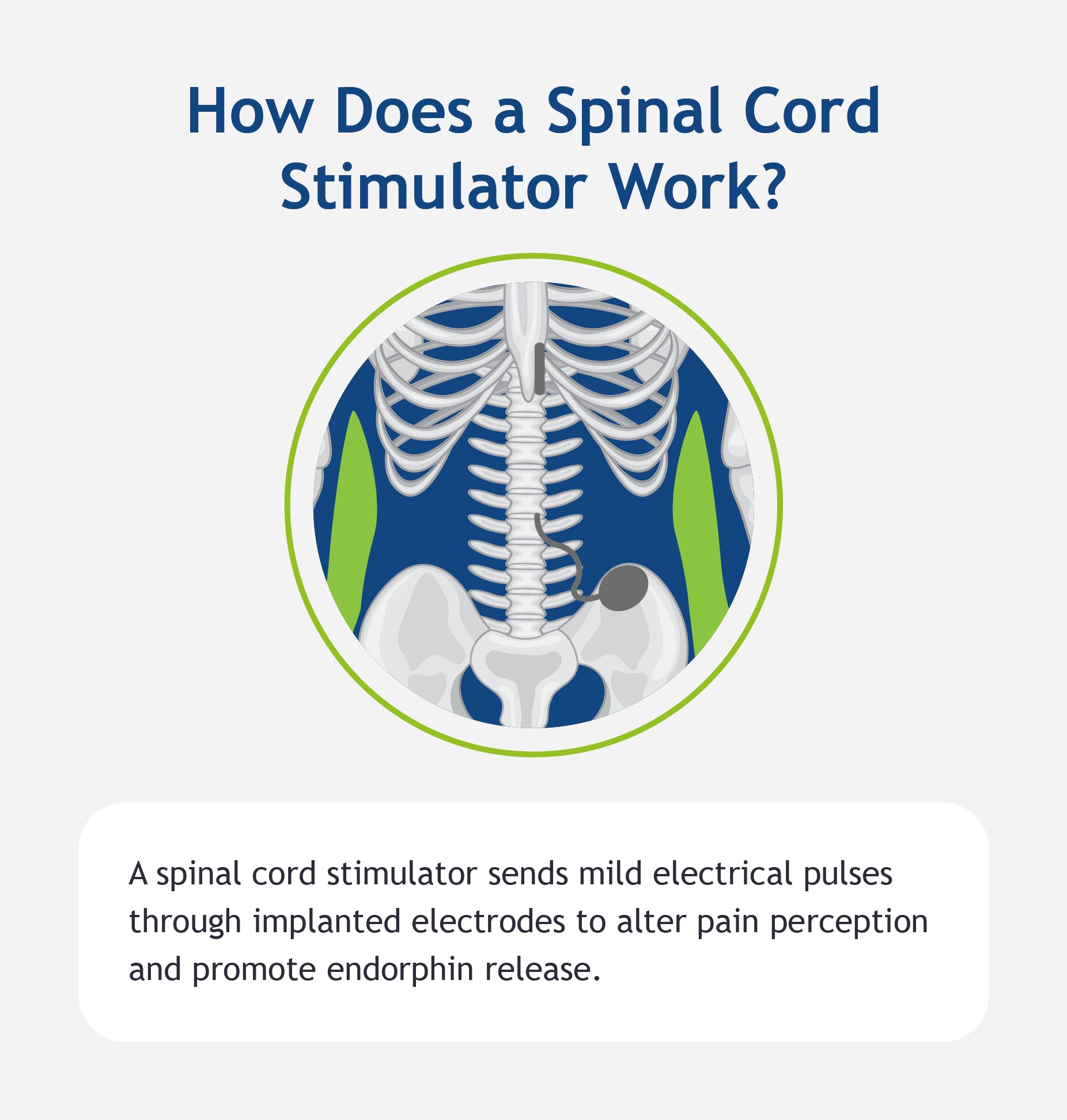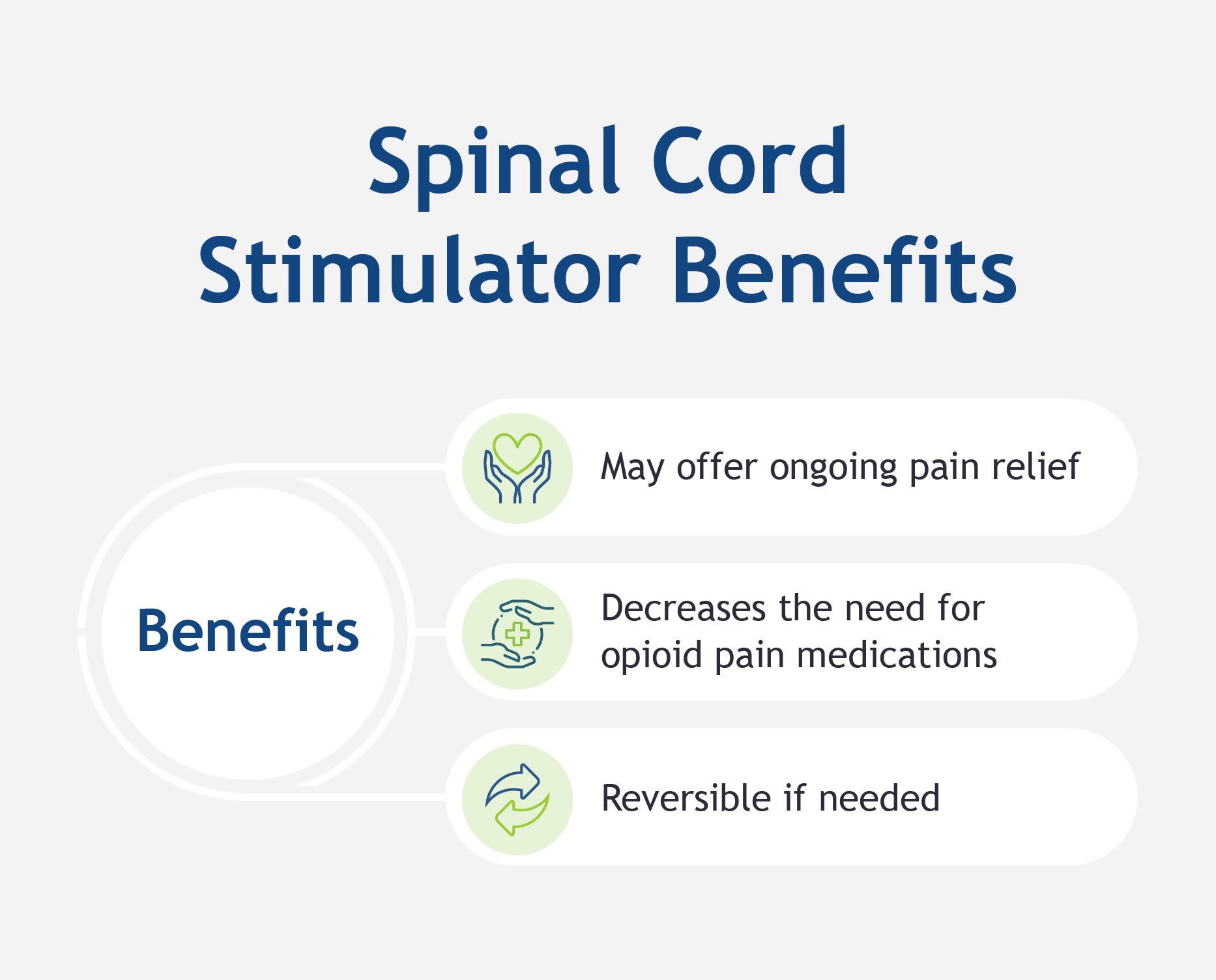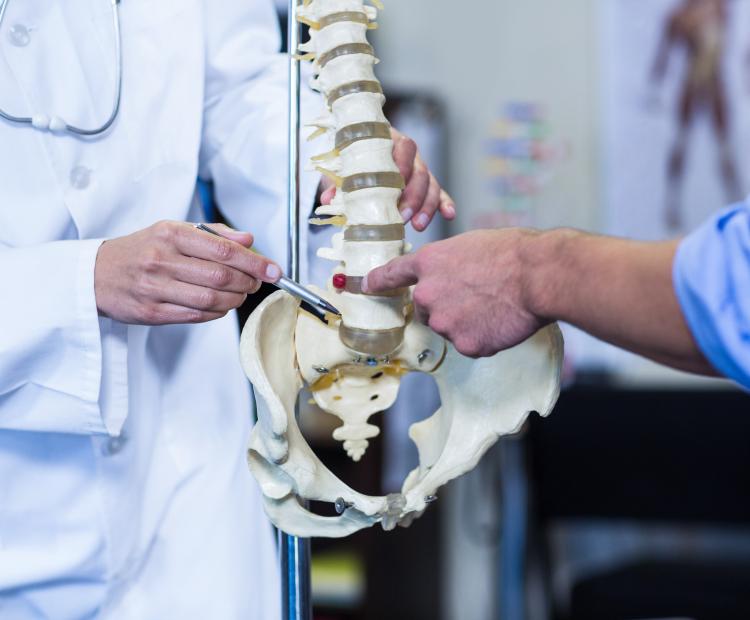A spinal cord stimulator is an implanted medical device that sends low-level electricity into the spinal cord to block pain signals and treat chronic pain.
According to the Centers for Disease Control and Prevention, an estimated 20.9%1 of adults in the United States experience chronic pain.
Spinal cord stimulation (SCS) may be an option to treat chronic pain when other types of treatment have not worked.
The guide below takes an in-depth look at how a spinal cord stimulator works, who it can help, and its benefits.
How Does a Spinal Cord Stimulator Work?
The FDA approved several spinal cord stimulation systems to treat chronic pain. Typically, each SCS device contains three main parts, which are:
- Electrodes: A wire with a varied number of electrodes delivers mild electrical pulses to the spinal cord
- A pulse generator: The generator creates the electrical pulses
- A hand-held remote: The remote turns the device on and off to adjusts the settings
The electrodes are implanted under the skin in specific areas of the epidural space. The generator is also placed under the skin, often near the abdomen.
The back stimulator allows individuals to deliver electrical impulses to the spine's nerve fibers when they feel pain. The exact mechanism of how a spinal cord stimulator provides pain relief is not fully known. However, researchers believe the electrical impulse alters how the brain senses pain. Delivering electrical stimulation may also promote the release of endorphins, which may provide pain relief.
Spinal cord stimulators can use both low-frequency and high-frequency currents to provide pain relief, depending on the severity of the pain. An SCS device that uses low-frequency current replaces the pain with a tingling feeling referred to as paraesthesia. High-frequency currents typically masks the pain bus does not cause a tingling sensation.

What Types of Chronic Pain Can an SCS Device Help?
An SCS device can help with various types of chronic pain. In most cases, a spinal cord stimulator is only used when other pain management options have failed, such as physical therapy. Spinal cord stimulation may be helpful in following conditions2:
- Complex regional pain syndrome: A chronic pains developed after surgery, injury, or heart attack that affects a leg or arm.
- Back pain: A condition developed for various reasons, such as injuries and degenerative disc disease. Back pain is widespread, with studies indicating that up to 84%3 of adults may experience back pain at some point in their lifetime.
- Arachnoiditis: An inflammation of the arachnoid, or the membrane covering the spinal cord and brain.
- Injuries to the spinal cord: Injuries to the spinal cord, such as a bruised or torn spinal cord, can also cause long-lasting pain.
- Nerve-related pain: Nerve-related pain may include neuropathy, which commonly develops with diabetes or as a side effect from chemotherapy for cancer treatment.
- Failed back surgery syndrome: When surgeries fail to provide back problem pain relief.
How is a Spinal Cord Stimulator Procedure Performed?
The process of spinal cord stimulation starts with a trial, which involves inserting one or two wire leads into the epidural space using an epidural needle. The patient controls the wires using a unit outside the body.
The procedure is similar to an epidural injection and does not require an incision. Usually, it is performed with just local anesthesia. The patient keeps the wires in place for about a week to determine how well it is helping with their pain. Doctors consider a trial successful if a patient reports a 50%4 reduction in pain.
During the trial, the patient can adjust the electrical signals to try to get the best improvement in their pain levels.
If the trial is successful, it is followed by spinal cord stimulation surgery to implant the permanent stimulator.
The implant surgery is performed under general anesthesia and involves making a small incision into the back and a second cut near the waist. A small electrode or wire is inserted through the cut in the back and placed behind the spinal cord. The doctor then threads the wire under the skin near the waist incision and connects it to the generator. The small generator is placed under the skin through the waist incision.
The generator is programmed using an external wireless programmer. The patient uses the programmer to adjust the stimulation level of the device and turn it on and off.
How Does a Spinal Cord Stimulator Provide Long-term Pain Relief?
When someone experiences pain, nociceptors, or nerves, send messages to the brain and spinal cord, alerting them to injury or damage to the body. The messages reach the brain in just a fraction of a second. The brain then responds with how you should feel. This complex system and process occurs quickly and determines how you feel pain.
A spinal cord stimulator interrupts the communication that triggers the pain, stopping the pain signals.
However, it is helpful to remember that spinal cord stimulation does not heal damage to the spinal cord, back, or other areas by eliminating the cause of the pain. Instead, it provides pain management by changing the way the brain perceives pain.
Research indicates that a spinal cord stimulator is up to 85%5 effective when placed within about two years of the onset of chronic pain.
Spinal Cord Stimulator Benefits
The extent of pain relief and success of spinal cord stimulation are variable. Success may depend on the severity of pain, underlying cause, and how long someone has been experiencing the pain. The potential benefits of spinal cord stimulation include the following:
- May provide continuous pain relief: Spinal cord stimulation can provide pain management for 24 hours a day all year long. Unlike a steroid injection and pain medication, which wear off, nerve stimulator offers continuous pain relief.
- Reduces the use of opioid pain medications: Some who develop chronic pain rely on pain medication, such as opioids. However, opioids have side effects and can possibly lead to problems with dependency. A neurostimulator implant provides a nonpharmacological option for pain management.
- Reversible if needed: Some types of surgery are non-reversible. If you want spinal cord stimulation reversed, the implant can be removed.

What to Expect After Spinal Cord Stimulation Surgery
Your specific circumstances may alter precisely what to expect after spinal cord implant surgery. In general, you will go home the same day after the surgery. After the permanent placement of the device, you may stay overnight in the hospital for a few days.
Your healthcare provider will instruct you on how to care for the procedure site and any precautions you should take while healing. This may include caring for the wound and changing the dressing. You will also be instructed on how to change the settings on the generator.
After surgery, you may have some mild swelling and discomfort at the incision site for a few days. You will have a follow-up appointment about two weeks after your procedure.
Complications of a Spinal Cord Stimulator Implant
Before undergoing spinal cord stimulation, your pain specialist will discuss potential benefits and possible surgical complications. Similar to any surgical procedure, there are possible complications and risks. However, serious complications are uncommon6.
Understanding the risks is essential when making an informed decision about any type of medical procedure. Possible complications of spinal cord stimulation include:
- Nerve injury: In rare cases, the stimulator insertion can damage a nerve. The risk of this complication has been reduced by using continuous fluoroscopy throughout the procedure.
- Infection: Infection is possible with any type of surgery, but the risk is low with proper quality control measures.
- Bleeding: Excess bleeding is also possible with any type of procedure that involves incisions.
- Lead migration: Once implanted, the electrodes may move from their original location. However, this complication may be reduced by following post-operative instructions, such as limiting lifting, bending, and twisting for a few months. If the electrodes move, follow-up surgery will be needed to put them back in the correct position.
- Dural puncture: Electrodes or needles that are inserted too deeply can puncture the dura, which surrounds the spinal cord. This may cause cerebrospinal fluid to leak out. Although this condition can lead to headaches, it is treatable.
- Allergic reaction: It is possible to have an allergic reaction to sedation given for the procedure.
Who is a Candidate for A Spinal Cord Stimulator?
The best way to determine if you are a candidate for a spinal cord stimulator is to come in for a consultation. In general, you may be a good candidate for a nerve stimulator if:
- You have intractable or long-term pain due to spinal stenosis, diabetic neuropathy, failed back surgery, or complex regional pain syndrome
- Conservative therapies have failed, such as injections and physical therapy
- You do not have medical conditions that prevent you from having an implant
- You do not have untreated drug addiction
- You had a successful SCS device trial
- You are in the earlier stages of chronic pain
What is the Difference Between a Spinal Cord Stimulator and Peripheral Nerve Stimulation?
Peripheral nerve stimulation is another type of neurostimulator implant. The electrode placement is the main difference between a spinal cord stimulator and peripheral nerve stimulation7.
The nervous system has two components: the peripheral nervous system (PNS) and the central nervous system (CNS). The CNS includes the brain and spinal cord, while the peripheral nervous system includes all the nerves outside of it.
The type of device a person needs depends on where the pain originates from. If pain is coming from the spine, a spinal cord stimulator implant may help. However, peripheral nerve stimulation may be the better option if the pain originates from outside the spine. For example, peripheral nerve stimulation may help with pain originating from areas, such as the shoulder, leg, or foot.
Summary
A spinal cord stimulator is an implanted device that sends electrical impulses to the spinal cord to manage pain. It may help provide pain relief for conditions, such as failed back surgery, complex regional pain syndrome, and spinal injuries. A nerve stimulator can be a useful option when other types of treatment have not relieved pain.
If you have any questions about spinal cord stimulation, we are happy to help. If you would like to schedule a consultation, please contact us today!
References
- Rikard SM, Strahan AE, Schmit KM, Guy GP JR. Chronic Pain Among Adults-United States, 2019-2021. MMWR Morb Mortal Wkly Rep 2023; 72:379-385. https://www.cdc.gov/mmwr/volumes/72/wr/mm7215a1.htm?s_cid=mm7215a1_w
- Sivanesan, E. Spinal Cord Stimulator. (n.d.). John Hopkins Medicine. https://www.hopkinsmedicine.org/health/treatment-tests-and-therapies/treating-pain-with-spinal-cord-stimulators
- Casiano VE, Sarwan G, Dydyk AM, et al. Back Pain. [Updated 2023 Dec 11]. In: StatPearls [Internet]. Treasure Island (FL): StatPearls Publishing; 2024 Jan. https://www.ncbi.nlm.nih.gov/books/NBK538173
- Spinal Cord Stimulator. (2022). Cleveland Clinic. https://my.clevelandclinic.org/health/treatments/24237-spinal-cord-stimulator-scs
- Dydyk AM, Tadi P. Spinal Cord Stimulator Implant. [Updated 2023 Jul 3]. In: StatPearls [Internet]. Treasure Island (FL): StatPearls Publishing; 2024 Jan. https://www.ncbi.nlm.nih.gov/books/NBK555994/
- Garcia K, Wray JK, Kumar S. Spinal Cord Stimulation. [Updated 2023 Apr 24]. In: StatPearls [Internet]. Treasure Island (FL): StatPearls Publishing; 2024 Jan. https://www.ncbi.nlm.nih.gov/books/NBK553154/
- Trent AR, Chopra P, Jain A. Peripheral Nerve Stimulator. [Updated 2023 Mar 13]. In: StatPearls [Internet]. Treasure Island (FL): StatPearls Publishing; 2024 Jan. https://www.ncbi.nlm.nih.gov/books/NBK539703/
- Log in to post comments

